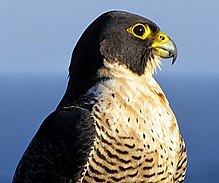| Falcons and caracaras Temporal range: Early Eocene – Holocene, 55–0 Ma PreꞒ Ꞓ O S D C P T J K Pg N | |
|---|---|

| |
| Peregrine falcon (Falco peregrinus) | |
| Scientific classification | |
| Domain: | Eukaryota |
| Kingdom: | Animalia |
| Phylum: | Chordata |
| Class: | Aves |
| Clade: | Eufalconimorphae |
| Order: | Falconiformes Sharpe, 1874 |
| Subtaxa | |
|
†Antarctoboenus | |
The order Falconiformes (/fælˈkɒnɪˌfɔːrmiːz/) is represented by the extant family Falconidae (falcons and caracaras) and a handful of enigmatic Paleogene species. Traditionally, the other bird of prey families Cathartidae (New World vultures and condors), Sagittariidae (secretarybird), Pandionidae (ospreys), Accipitridae (hawks) were classified in Falconiformes. A variety of comparative genome analyses published since 2008, however, found that falcons are part of a clade of birds called Australaves, which also includes seriemas, parrots and passerines. Within Australaves falcons are more closely related to the parrot-passerine clade than they are to the seriemas. The hawks, vultures and owls are placed in the clade Afroaves.
The cladogram of the Telluraves shown below is based on the study by Josefin Stiller and collaborators published in 2024. The species numbers are taken from the December 2023 version of the list maintained by Frank Gill, Pamela C. Rasmussen and David Donsker on behalf of the International Ornithological Committee (IOC). This list includes the Cathartiformes (New World vultures) in the order Accipitriformes.
| Telluraves |
| ||||||||||||||||||||||||||||||||||||||||||||||||||||||||||||||||||||||||
The fossil record of Falconiformes sensu stricto is poorly documented. The only stem-falcons that have mostly complete remains are Masillaraptor parvunguis and Danielsraptor phorusrhacoides, while the other taxa Stintonornis mitchelli and Parvulivenator watteli are known from fragmentary remains. Mayr (2009) noted the similarity of Masillaraptor to the seriemas. One study from Wang et al. (2012) using 30 nuclear loci from 28 taxa found Falconidae and Cariamidae being sister taxa to each other. This has, however, not been supported by the latest major neoavian phylogenetic studies. A 2022 study recovers masillaraptorids as true falcons.
References
- Hackett, Shannon J.; Kimball, Rebecca T.; Reddy, Sushma; Bowie, Rauri C. K.; Braun, Edward L.; Braun, Michael J.; Chojnowski, Jena L.; Cox, W. Andrew; et al. (2008). "A Phylogenomic Study of Birds Reveals Their Evolutionary History". Science. 320 (5884): 1763–68. Bibcode:2008Sci...320.1763H. doi:10.1126/science.1157704. PMID 18583609. S2CID 6472805.
- ^ Jarvis, E.D.; et al. (2014). "Whole-genome analyses resolve early branches in the tree of life of modern birds". Science. 346 (6215): 1320–1331. Bibcode:2014Sci...346.1320J. doi:10.1126/science.1253451. PMC 4405904. PMID 25504713.
- ^ Prum, Richard O.; Berv, Jacob S.; Dornberg, Alex; Field, Daniel J.; Townsend, Jeffrey P.; Lemmon, Emily Moriarty; Lemmon, Alan R. (2015). "A comprehensive phylogeny of birds (Aves) using targeted next-generation DNA sequencing". Nature. 526 (7574): 569–573. Bibcode:2015Natur.526..569P. doi:10.1038/nature15697. PMID 26444237. S2CID 205246158.
- Alexander Suh; Martin Paus; Martin Kiefmann; Gennady Churakov; Franziska Anni Franke; Jürgen Brosius; Jan Ole Kriegs; Jürgen Schmitz (2011). "Mesozoic retroposons reveal parrots as the closest living relatives of passerine birds". Nature Communications. 2 (8): 443. Bibcode:2011NatCo...2..443S. doi:10.1038/ncomms1448. PMC 3265382. PMID 21863010.
- ^ Stiller, J.; et al. (2024). "Complexity of avian evolution revealed by family-level genomes". Nature. 629 (8013): 851–860. Bibcode:2024Natur.629..851S. doi:10.1038/s41586-024-07323-1. PMC 11111414. PMID 38560995.
- Gill, Frank; Donsker, David; Rasmussen, Pamela, eds. (December 2023). "IOC World Bird List Version 14.1". International Ornithologists' Union. Retrieved 26 June 2024.
- Mayr, G. (2018). "Phylogeny, Taxonomy, and Geographic Diversity of Diurnal Raptors: Falconiformes, Accipitriformes, and Cathartiformes". Birds of Prey. Berlin, Heidelberg: Springer. pp. 3–32. doi:10.1007/978-3-319-73745-4_1. ISBN 978-3-540-89627-2.
- Wang, N.; Braun, E. L.; Kimball, R. T. (2012). "Testing Hypotheses about the Sister Group of the Passeriformes Using an Independent 30-Locus Data Set". Molecular Biology and Evolution. 29 (2): 737–750. doi:10.1093/molbev/msr230. PMID 21940640.
- Suh, Alexander (2016). "The phylogenomic forest of bird trees contains a hard polytomy at the root of Neoaves". Zoologica Scripta. 45: 50–62. doi:10.1111/zsc.12213. ISSN 0300-3256.
- Reddy, Sushma; Kimball, Rebecca T.; Pandey, Akanksha; Hosner, Peter A.; Braun, Michael J.; Hackett, Shannon J.; Han, Kin-Lan; Harshman, John; Huddleston, Christopher J.; Kingston, Sarah; Marks, Ben D.; Miglia, Kathleen J.; Moore, William S.; Sheldon, Frederick H.; Witt, Christopher C.; Yuri, Tamaki; Braun, Edward L. (2017). "Why Do Phylogenomic Data Sets Yield Conflicting Trees? Data Type Influences the Avian Tree of Life more than Taxon Sampling". Systematic Biology. 66 (5): 857–879. doi:10.1093/sysbio/syx041. ISSN 1063-5157. PMID 28369655.
- Braun, Edward L.; Cracraft, Joel; Houde, Peter (2019). "Resolving the Avian Tree of Life from Top to Bottom: The Promise and Potential Boundaries of the Phylogenomic Era". Avian Genomics in Ecology and Evolution. pp. 151–210. doi:10.1007/978-3-030-16477-5_6. ISBN 978-3-030-16476-8. S2CID 198399272.
- Houde, Peter; Braun, Edward L.; Narula, Nitish; Minjares, Uriel; Mirarab, Siavash (2019). "Phylogenetic Signal of Indels and the Neoavian Radiation". Diversity. 11 (7): 108. doi:10.3390/d11070108. ISSN 1424-2818.
- Kuhl., H.; Frankl-Vilches, C.; Bakker, A.; Mayr, G.; Nikolaus, G.; Boerno, S. T.; Klages, S.; Timmermann, B.; Gahr, M. (2020). "An unbiased molecular approach using 3'UTRs resolves the avian family-level tree of life". Molecular Biology and Evolution. 38: 108–127. doi:10.1093/molbev/msaa191. PMC 7783168. PMID 32781465.
- Mayr, Gerald; Kitchener, Andrew C. (2022). "New fossils from the London Clay show that the Eocene Masillaraptoridae are stem group representatives of falcons (Aves, Falconiformes)". Journal of Vertebrate Paleontology. 41 (6): e2083515. doi:10.1080/02724634.2021.2083515. S2CID 250402777.
| Genera of falcons and their extinct allies | |||||||||||||||||||
|---|---|---|---|---|---|---|---|---|---|---|---|---|---|---|---|---|---|---|---|
| |||||||||||||||||||
| |||||||||||||||||||
| Taxon identifiers | |
|---|---|
| Falconiformes |
|
This Falconiformes article is a stub. You can help Misplaced Pages by expanding it. |